The Rottweiler is a large and powerful dog breed originally from Germany, often kept as a herding dog due to its strong and imposing build. Despite their fierce reputation, Rottweilers are incredibly loyal and affectionate, making them a popular choice for those seeking a protective yet loving companion. This guide will cover everything you need to know about properly caring for and training your Rottweiler.
1 Understanding the Rottweiler Breed
Origin of Rottweilers
Rottweilers, or ‘Rotties’ as they are affectionately known, have a long history dating back to ancient Rome. These dogs were bred to drive cattle and pull carts, which is why they are known for their strength and endurance. Over time, they became popular in Germany, particularly in the town of Rottweil, from which they get their name. Rottweilers were officially recognized as a breed in 1901 and have since become one of the most recognizable dog breeds in the world.
Classification of Rottweilers
There are two main types of Rottweilers: the standard Rottweiler and the miniature Rottweiler. The standard Rottweiler, also known as the Rottweiler Groß, has an average weight of 50kg and a height of 60cm. On the other hand, the miniature Rottweiler, or Mittel Rottweiler, is smaller in stature, typically weighing less than 50kg and standing under 60cm tall.
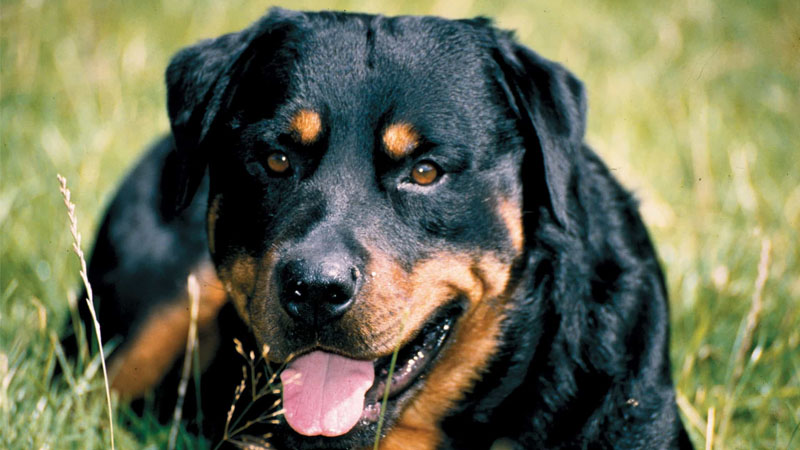 Rottweilers originate from Germany and are known for their strong, imposing build.
Rottweilers originate from Germany and are known for their strong, imposing build.
Physical Characteristics of Rottweilers
Rottweilers are large, muscular dogs, especially in the shoulders, chest, and hips. Despite their bulky appearance, they are incredibly agile and fast. Their heads are relatively round with a square jaw, and they have a broad muzzle with well-developed jaws, giving them a formidable appearance. Their eyes are typically a deep brown or black color with yellow spots above, and their ears are folded forward.
The Rottweiler’s coat is short and coarse, with the body usually black with mahogany or tan markings on the legs, muzzle, neck, and chest. Their tails are often docked short, giving them a distinctive look.
Temperament and Personality Traits
Rottweilers have a reputation for being fierce guard dogs, but they are also incredibly loving and loyal companions. They are highly intelligent, active, and obedient, making them excellent working dogs. However, due to their strong protective instincts, early socialization and consistent training are crucial to ensure they do not become overly aggressive or territorial.
2 Feeding and Nutritional Needs of Rottweilers
Diet and Food Options for Rottweilers
A balanced diet is essential for the overall health and well-being of your Rottweiler. While commercial dog food is convenient, it’s important to vary their meals with fresh, whole foods to keep them interested and ensure they get a range of nutrients. A typical Rottweiler diet includes various meats (such as beef and pork), fish, seafood, organ meats (liver, heart, lungs, etc.), eggs, grains, vegetables, and fruits.
Nutritional Requirements at Different Life Stages
The nutritional needs of a Rottweiler will change as it grows, so it’s important to adjust their diet accordingly.
Puppies (2 months old): Rottweiler puppies are often chosen at this age as they are easier to train and imprint upon. They require a diet rich in nutrients to support their rapid growth and development. Soft, mashed, or finely chopped food is best, as they are still weaning and cannot handle large, hard pieces.
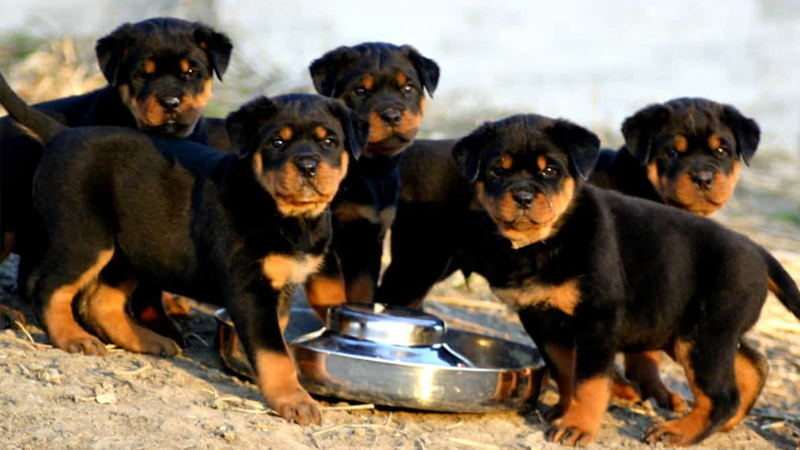 Rottweiler puppies at 2-3 months old require a nutrient-rich diet to support their growth.
Rottweiler puppies at 2-3 months old require a nutrient-rich diet to support their growth.
Young Dogs (3-5 months old): As your Rottweiler enters its teenage phase, you can start reducing the number of meals while increasing the portion size. Three meals a day are usually sufficient, and some Rottweilers may even transition to two meals a day. It’s important to establish good eating habits at this stage.
Note: At this age, it’s safe to introduce bones, but they should be large, raw, and uncooked to prevent choking hazards.
 Rottweilers aged 3-5 months old are in their teenage phase and require a balanced diet.
Rottweilers aged 3-5 months old are in their teenage phase and require a balanced diet.
Adult Dogs (over 5 months old): During this period, you’ll notice significant changes in your Rottweiler’s physique as their muscles develop. Two meals a day are usually sufficient, but the portion size should be increased to meet their higher energy requirements.
Since Rottweilers are active and have large physiques, they require a diet rich in protein and other essential nutrients.
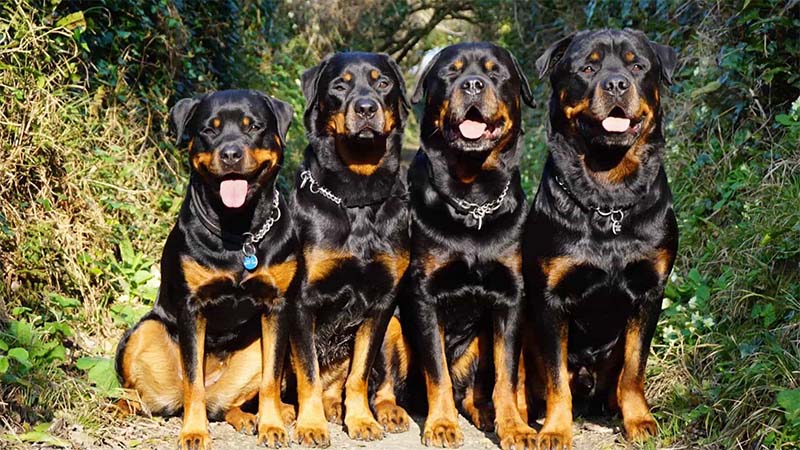 Adult Rottweilers over 5 months old require a diet high in protein and other essential nutrients.
Adult Rottweilers over 5 months old require a diet high in protein and other essential nutrients.
Feeding Tips for Breeding Rottweilers
Female Rottweilers are typically very fertile and can produce large litters of up to 12 puppies. It’s important to provide extra care and attention to the mother during pregnancy and after giving birth.
Pregnancy Diet: During pregnancy, a female Rottweiler’s nutritional needs increase significantly. Design a diet plan for each stage of pregnancy, starting with three meals a day that are rich in protein, calcium, and other essential nutrients. As the pregnancy progresses, increase the number of meals to four per day while maintaining the same nutritional content to ensure the mother has the energy she needs to support her growing litter.
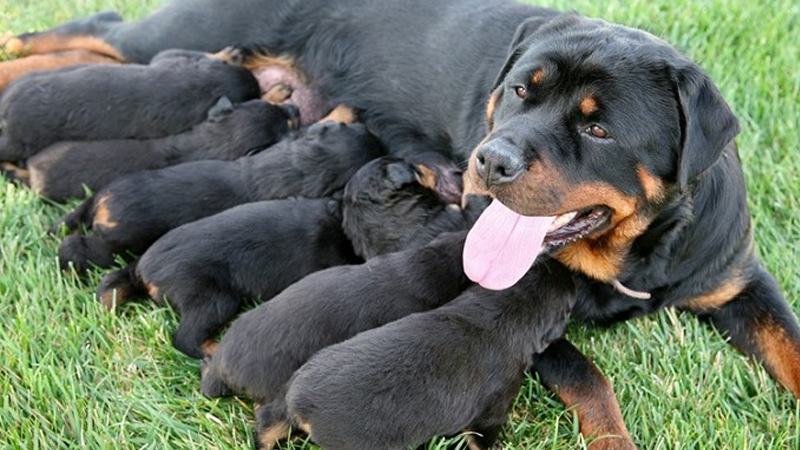 Female Rottweilers are typically very fertile and require extra care during pregnancy.
Female Rottweilers are typically very fertile and require extra care during pregnancy.
Post-Pregnancy Care: After giving birth, continue to provide a nutritious diet to help the mother regain her strength and produce milk for her puppies. Keep an eye on her weight and adjust her diet as needed to ensure she stays healthy.
Observing Your Dog’s Behavior: Pay attention to your dog’s behavior during pregnancy. Take her for walks and ensure she has a comfortable, cool space to rest and prepare for childbirth. If you notice signs such as loss of appetite, rapid breathing, or nesting behavior, it’s a sign that labor may be imminent.
 Observe your Rottweiler’s behavior during pregnancy and provide a comfortable space for her to rest.
Observe your Rottweiler’s behavior during pregnancy and provide a comfortable space for her to rest.
Grooming and Hygiene for Rottweilers
Rottweilers are active and playful, so it’s important to provide them with plenty of exercise and stimulation. Spend time running, playing, and training with your Rottweiler to strengthen your bond and ensure they get the physical activity they need.
 Rottweilers require regular exercise and grooming to stay healthy and happy.
Rottweilers require regular exercise and grooming to stay healthy and happy.
In terms of grooming, Rottweilers have short, smooth coats that are easy to maintain. Brushing their coat with a soft-bristled brush once a week is usually sufficient, and they only need to be bathed occasionally when necessary.
Common Health Issues in Rottweilers
Rottweilers are generally healthy, but they are prone to certain health issues, including allergies, bloat (gastric dilatation-volvulus), hip dysplasia, and bone cancer. They may also be susceptible to hereditary conditions, snoring, and eye problems. Regular check-ups and preventative care are essential to catch any potential issues early on.
Important Considerations When Caring for Rottweilers
– Nutrition: Ensure your Rottweiler’s diet is tailored to their age and life stage, providing the necessary nutrients for their development and health.
– Exercise: Rottweilers require daily exercise to stay healthy and happy. Aim for at least 30 minutes of activity each day, including walks, runs, and playtime.
– Health: Be aware of the common health issues that Rottweilers may face, and take your dog for regular check-ups and vaccinations to prevent and treat any potential problems.
– Training: Early socialization and consistent training are crucial for Rottweilers to ensure they grow up to be well-behaved and obedient.
3 Buying a Rottweiler: What to Consider
Price Range of Rottweilers
Rottweilers from Thailand or Indonesia: Reputable breeders in these countries produce healthy and high-quality Rottweilers. The price range for a standard Rottweiler with purebred parents is typically between $600 and $700. For a Rottweiler with more complete VKA paperwork, the price can range from $800 to $1,200.
Rottweilers from Europe or America: Rottweilers imported from countries like Germany can cost anywhere from $2,000 to $5,000, depending on their lineage and show quality. Dogs with a proven track record in Dogshows can command higher prices.
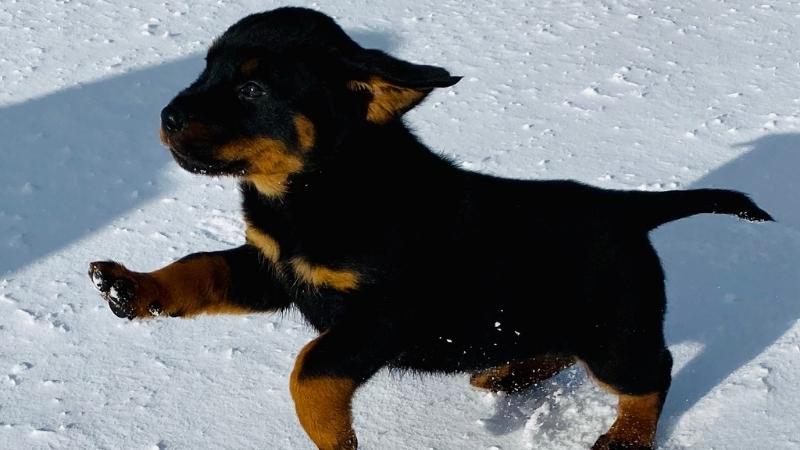 Consider the price range and health of the Rottweiler when purchasing from a breeder.
Consider the price range and health of the Rottweiler when purchasing from a breeder.
Things to Look Out for When Buying a Rottweiler
When purchasing a Rottweiler puppy from a breeder, take the time to assess the following:
– Coat Condition: A healthy puppy should have a shiny, smooth coat with no signs of skin irritation or parasites.
– Legs and Feet: The legs should be strong and straight, with the front legs set wide apart and the back legs set slightly wider.
– Body Proportions: The back should be straight and sturdy, with a short, deep waist. The hips should be broad and slightly rounded, and the chest should be well-developed.
– Head Shape: The forehead should have a gentle curve from the eyes to the end of the muzzle, providing protection for the skull.
– Ears: The ears should be set high and hang close to the head, blending harmoniously with the overall appearance.
– Eye Color: The ideal eye color for a Rottweiler is dark brown, amber, or black. Lighter eyes are acceptable but avoid dogs with white spots in their eyes, as this may indicate poor genetic health.
This guide has provided you with a comprehensive understanding of Rottweilers, from their history and characteristics to their nutritional needs and care requirements. We hope it has inspired you to learn more about these incredible dogs and consider welcoming one into your family.
Do you have a soft spot for Rottweilers, or is there another breed that has captured your heart? Share your thoughts and experiences with us in the comments, and don’t forget to pass on these helpful tips to any aspiring Rottweiler owners out there!






























